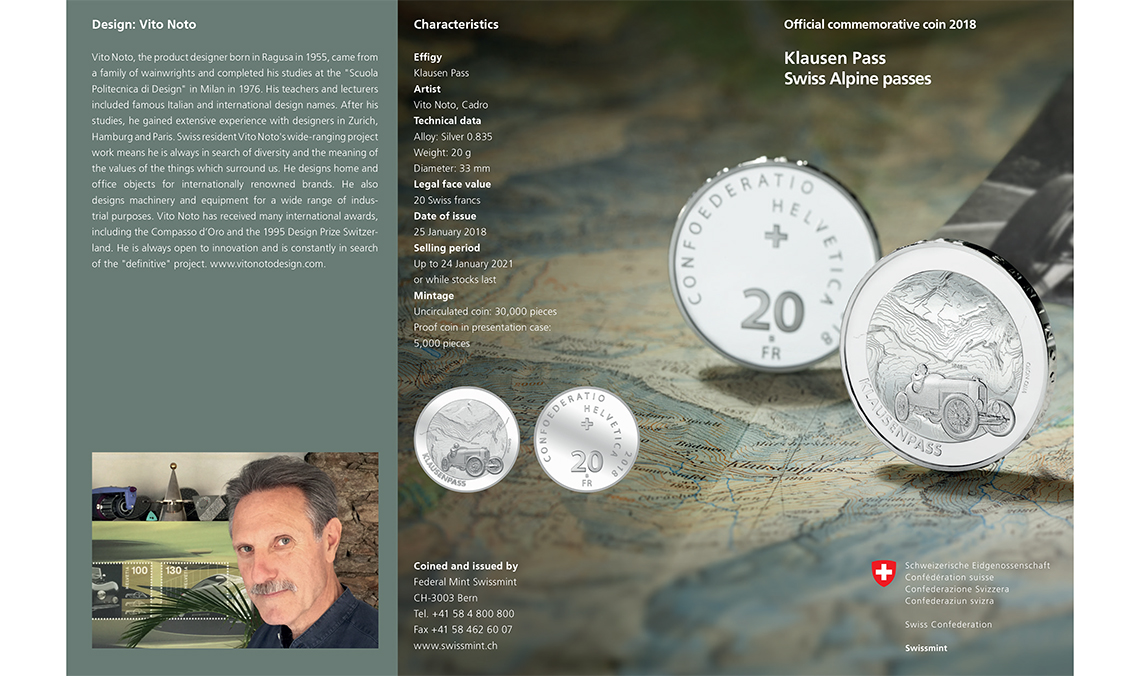
Design: Vito Noto
Vito Noto, the product designer born in Ragusa in 1955, came from a family of wainwrights and completed his studies at the “Scuola Politecnica di Design” in Milan in 1976. His teachers and lecturers included famous Italian and international design names. After his studies, he gained extensive experience with designers in Zurich, Hamburg and Paris. Swiss resident Vito Noto’s wideranging project work means he is always in search of diversity and the meaning of the values of the things which surround us.
He designs home and office objects for internationally renowned brands. He also designs machinery and equipment for a wide range of industrial purposes. Vito Noto has received many international awards, including the Compasso d’Oro and the 1995 Design Prize Switzerland. He is always open to innovation and is constantly in search of the “definitive” project. www.vitonoto.design.
Official commemorative coins
Each year, the Federal Mint Swissmint issues a small number of commemorative coins featuring carefully selected subjects.
The coins in bimetal, silver and gold bear an official nominal value and are available in various minting qualities – as collectors’ pieces in their own right or as an exquisite gift.
Klausen Pass
The 1,948 metre-high Klausen pass is 46km long and links the valley of Schächental in the canton of Uri with the rear of Linthal in the canton of Glarus. As a non-transalpine route, the Klausen pass was of no significance during either Roman times or the Middle Ages. However, no later than the High Middle Ages, a simple cattle track existed which was mostly used for moving cattle to the Alpine pastures on the Urnerboden. A customs post in Bürglen monitored the insignificant local trade. Following Alpine disputes concerning the border between Uri and Glarus on the Urnerboden (it runs through the side of the mountain pass away from Uri), an agreement was reached in the 12th century. Commercial interest in a road over the Klausen pass grew with the opening of the Gotthard railway line in 1882 because the new north-south route was reliant on linkroads. After the project received the army’s support, it was quickly built between 1893 and 1899. The big day came on 15 June 1900: the first stagecoach drove over the mountain pass and opened up the magnificent landscape between Linthal and Altdorf to tourism. The Klausen pass gained fame from the legendary Klausenrace, a historic mountain race for cars and motorcycles.
Source: Wikipedia
Furka Pass
At an altitude of 2429 metres above sea level, the Furka Pass is one of the highest and most impressive Alpine passes in Switzerland. It connects the hamlet of Gletsch in the canton of Valais with Andermatt in the canton of Uri and, together with the Oberalp Pass, forms an east-west link within the Alps. The area is one of the snowiest in Switzerland. The European watershed runs along the pass: the Rhone flows southwest towards the Mediterranean, while the (Furka-)Reuss sweeps northeast into the Rhine and the North Sea.
The first landmark event in Furka Pass traffic to be documented was around the 12th century, when hundreds of German-speaking Walser people settled with their families in the Urseren Valley or even further east in Raetia. In the 14th century, the route over the pass summit at 2429 metres a.s.l. gained in importance for the Walser people because it granted them direct access to the transalpine axis via the Gotthard. Between 1864 and 1866, the almost 40-kilometre-long and at least 4.20 metres wide road from Hospental to Oberwald was built by the cantons of Uri and Valais.
Whether by bicycle, motorbike, car, postal bus or historic steam train on the cogwheel mountain route – every year more than 250,000 people cross the Furka Pass and enjoy the spectacular view. For example from the famous Hotel Belvédère on the Rhone glacier or the surrounding alpine granite world.
Susten Pass
As far back as the Middle Ages, there has been a trade route over the Susten Pass. However, apart from periods when neighbouring passes were closed, it was always less important as a north-south trade route than the Brünig-Grimsel-Gries / Albrun to the west and the Gotthard to the east. But during the religious conflict between the protestant and catholic parts of Switzerland, the Susten Pass acquired a degree of military importance.
The old bridle path was first converted into a navigable road in 1811. Before the Second World War, the army demanded the construction of a modern route between the cantons of Bern and Uri for strategic reasons. But there were other reasons too, such as encouraging tourism and promoting economic development in this mountainous region. The current pass road is 45km long and connects Wassen in Uri’s Meiental with Meiringen in the Haslital of the canton of Bern. Construction took place between 1938 and 1946. The aim was to involve as much manual labour as possible and to blend the construction into the landscape, which is why all the retaining walls were clad in natural stone. Unlike the old Susten Pass road (2,259 metres above sea level), the new road passes underneath the top of the pass in a summit tunnel 2,224 metres above sea level. The Susten Pass is open from around mid-June to mid-October each year and whoever travels along its numerous bridges and tunnels will be able to enjoy a superb mountain landscape.
Swissmint
2020